Related Research Articles
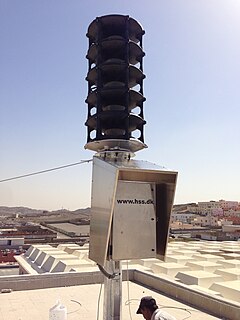
A civil defense siren is a siren used to provide an emergency population warning to the general population of approaching danger. It is sometimes sounded again to indicate the danger has passed. Some sirens are also used to call the volunteer fire department when needed. Initially designed to warn city dwellers of air raids in World War II, they were later used to warn of nuclear attack and natural destructive weather patterns such as tornadoes. The generalized nature of sirens led to many of them being replaced with more specific warnings, such as the broadcast-based Emergency Alert System and the Cell Broadcast-based Wireless Emergency Alerts and EU-Alert mobile technologies.

The Emergency Alert System (EAS) is a national warning system in the United States designed to allow authorized officials to coordinate and disseminate emergency alerts and warning messages to the public via terrestrial and satellite radio and television, including broadcast and multichannel television.

A tornado warning is a severe weather warning product issued by regional offices of weather forecasting agencies throughout the world to alert the public when a tornado has been reported or indicated by weather radar within the parent severe thunderstorm. It can be issued after a tornado, funnel cloud and rotation in the clouds has been witnessed by the public, storm chasers, emergency management or law enforcement, and indicates that residents in the affected areas should take immediate safety precautions.
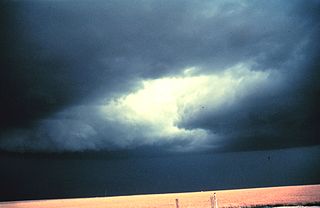
A severe thunderstorm warning is a severe weather warning product issued by regional offices of weather forecasting agencies throughout the world to alert the public that severe thunderstorms are imminent or occurring. A severe thunderstorm warning is issued when Doppler weather radar, trained storm spotters or local emergency management personnel indicate that a thunderstorm is producing large hail and high winds capable of causing significant damage, and is expected to continue producing severe weather along the storm's projected track. Flooding is also sometimes caused by torrential rainfall produced by a thunderstorm.

The National Weather Service (NWS) is an agency of the United States federal government that is tasked with providing weather forecasts, warnings of hazardous weather, and other weather-related products to organizations and the public for the purposes of protection, safety, and general information. It is a part of the National Oceanic and Atmospheric Administration (NOAA) branch of the Department of Commerce, and is headquartered in Silver Spring, Maryland, within the Washington metropolitan area. The agency was known as the United States Weather Bureau from 1890 until it adopted its current name in 1970.
Specific Area Message Encoding (SAME) is a protocol used for framing and classification of broadcast emergency warning messages. It was developed by the United States National Weather Service for use on its NOAA Weather Radio (NWR) network, and was later adopted by the Federal Communications Commission for the Emergency Alert System, then subsequently by Environment Canada for use on its Weatheradio Canada service. It is also used to set off receivers in Mexico City and surrounding areas as part of the Mexican Seismic Alert System (SASMEX).

NOAA Weather RadioNWR; also known as NOAA Weather Radio All Hazards is an automated 24-hour network of VHF FM weather radio stations in the United States (U.S.) that broadcast weather information directly from a nearby National Weather Service office. The routine programming cycle includes local or regional weather forecasts, synopsis, climate summaries or zone/lake/coastal waters forecasts. During severe conditions the cycle is shortened into: hazardous weather outlooks, short-term forecasts, special weather statements or tropical weather summaries. It occasionally broadcasts other non-weather related events such as national security statements, natural disaster information, environmental and public safety statements, civil emergencies, fires, evacuation orders, and other hazards sourced from the Federal Communications Commission's (FCC) Emergency Alert System. NOAA Weather Radio uses automated broadcast technology that allows for the recycling of segments featured in one broadcast cycle seamlessly into another and more regular updating of segments to each of the transmitters. It also speeds up the warning transmitting process.
The Common Alerting Protocol (CAP) is an XML-based data format for exchanging public warnings and emergencies between alerting technologies. CAP allows a warning message to be consistently disseminated simultaneously over many warning systems to many applications, such as Google Public Alerts and Cell Broadcast. CAP increases warning effectiveness and simplifies the task of activating a warning for responsible officials.

The Pacific Tsunami Warning Center (PTWC) is one of two tsunami warning centers that are operated by NOAA in the United States. Headquartered on Ford Island, HI, the PTWC is part of an international tsunami warning system (TWS) program and serves as the operational center for TWS of the Pacific issuing bulletins and warnings to participating members and other nations in the Pacific Ocean area of responsibility. It is also the regional (local) warning center for the State of Hawaii. The other tsunami warning center is the National Tsunami Warning Center (NTWC) in Palmer, Alaska, serving all coastal regions of Canada and the United States except Hawaii, the Caribbean Sea and the Gulf of Mexico.
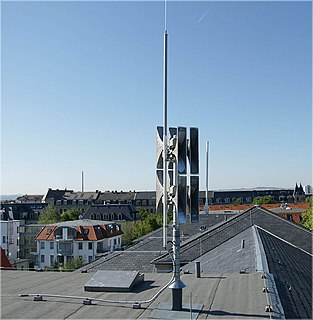
An emergency population warning is a method whereby local, regional, or national authorities can contact members of the public en masse to warn them of an impending emergency. These warnings may be necessary for a number of reasons, including:
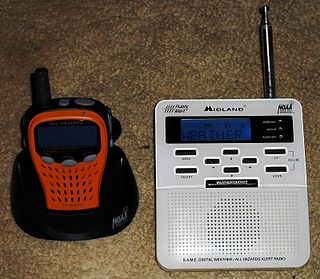
A weather radio is a specialized radio receiver that is designed to receive a public broadcast service, typically from government-owned radio stations, dedicated to broadcasting weather forecasts and reports from the National Weather Service on a continual basis, with the routine weather reports being interrupted by emergency weather reports whenever needed. Weather radios are typically equipped with a standby alerting function—if the radio is muted or tuned to another band and a severe weather bulletin is transmitted, it can automatically sound an alarm and/or switch to a pre-tuned weather channel for emergency weather information.
Citizen Corps is a program under the Department of Homeland Security that provides training for the population of the United States to assist in the recovery after a disaster or terrorist attack. Each local Citizen Corps Council partners with organizations, volunteers and businesses to organize responders, volunteers and professional first responders for an efficient response so efforts are not wasted by being duplicated. By training in Incident Command, volunteers know whom to report to and how the incident is organized. This prevents sites from being inundated by untrained and unprepared personnel preventing operation. Citizen Corps also works in conjunction with the Corporation for National and Community Service in promoting national service opportunities for promoting homeland security needs.
The National Warning System (NAWAS) is an automated telephone system used to convey warnings to United States-based federal, state and local governments, as well as the military and civilian population. The original mission of NAWAS was to warn of an imminent enemy attack or an actual accidental missile launch upon the United States. NAWAS still supports this mission but the emphasis is on natural and technological disasters. Organizations are able to disseminate and coordinate emergency alerts and warning messages through NAWAS and other public systems by means of the Integrated Public Alert and Warning System.
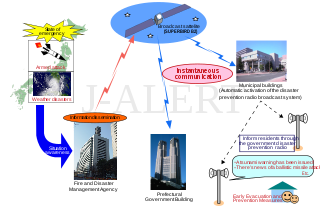
J-Alert is the early warning system used in Japan. J-Alert was launched in February 2007. The system is designed to quickly inform the public of threats and emergencies such as earthquakes, severe weather, and other dangers. The system was developed in the hope that early warnings would speed up evacuation times and help coordinate emergency response.
The Mount Rainier Volcano Lahar Warning System consists of two separate components, operating in tandem: Acoustic Flow Monitors (AFM) and the All Hazard Alert Broadcast (AHAB) sirens. The AFM system was developed by the United States Geological Survey (USGS) in 1998 and is now maintained by Pierce County Emergency Management. The purpose of the warning system is to assist in the evacuation of residents in the river valleys around Mount Rainier, a volcano in Washington, in the event of a lahar. Pierce County works in partnership with the USGS, the Pacific Northwest Seismic Network (PNSN), Washington Military Department's Emergency Management Division, and South Sound 9-1-1 to monitor and operate the system.

Wireless Emergency Alerts, is an alerting network in the United States designed to disseminate emergency alerts to mobile devices such as cell phones and pagers. Organizations are able to disseminate and coordinate emergency alerts and warning messages through WEA and other public systems by means of the Integrated Public Alert and Warning System.
The Integrated Public Alert and Warning System (IPAWS) is an architecture that unifies the United States' Emergency Alert System, National Warning System, Wireless Emergency Alerts, and NOAA Weather Radio, under a single platform. IPAWS was designed to modernize these systems by enabling alerts to be aggregated over a network and distributed to the appropriate system for public dissemination.
ALERT FM is an emergency notification system that delivers messages from state, local, and/or private sector officials to citizens, schools, businesses, and first responders using the Radio Data System of local FM radio stations. Messages are transported from a secure web-based portal to the data sub-carrier via GSSNet, a satellite data delivery system. These alerts and messages are then received on ALERT FM receivers or on cell phones equipped with active FM chips and properly installed software.
The term "tornado preparedness" refers to safety precautions made before the arrival of and during a tornado. Historically, the steps taken have varied greatly, depending on location, or time remaining before a tornado was expected. For example, in rural areas, people might prepare to enter an external storm cellar, in case the main building collapses, and thereby allow exit without needing rescue from the main building as in urban areas. Because tropical storms have spawned many tornadoes, hurricane preparations also involve tornadoes. The term "tornado preparedness" has been used by government agencies, emergency response groups, schools, insurance companies, and others.
Evacuation immediate is a warning issued through the Emergency Alert System (EAS) in the United States to notify the public of a mandatory evacuation due to a wildfire, approaching hurricane, or an imminent explosion due to a gas leak. It is typically issued by a local or state authority and is relayed by the National Weather Service. The warning can replace a Civil Emergency Message, Fire Warning, or other warnings when required.
References
- ↑ https://finance.yahoo.com/news/City-of-Indialantic-Adopts-bw-13811136.html [ dead link ]
- ↑ http://www.floridatoday.com/article/20081231/BUSINESS/812310310/1006/NEWS01
- ↑ "Archived copy". Forbes . Archived from the original on 2008-12-06. Retrieved 2017-08-29.
{{cite web}}: CS1 maint: archived copy as title (link) - ↑ "Archived copy". Archived from the original on 2009-08-23. Retrieved 2009-01-15.
{{cite web}}: CS1 maint: archived copy as title (link) - ↑ "Archived copy". Archived from the original on 2015-09-19. Retrieved 2015-10-26.
{{cite web}}: CS1 maint: archived copy as title (link)